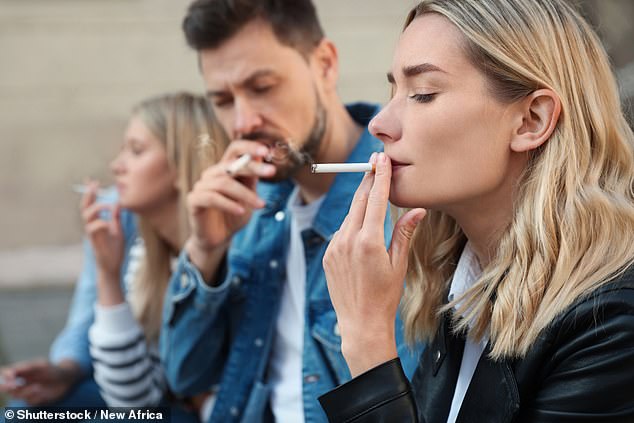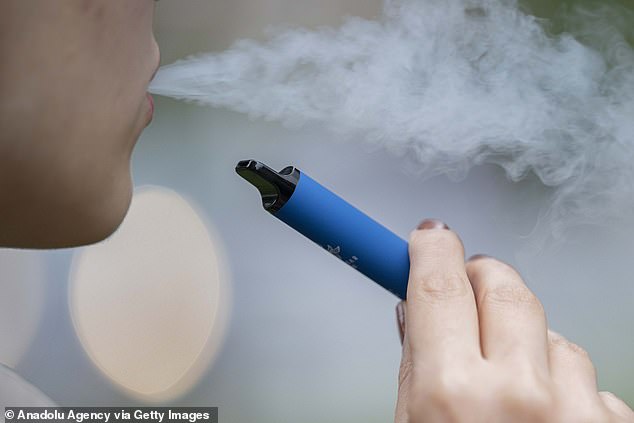How a ban on vaping could lead to more young people taking up smoking as new research shows young people see vaping and cigarettes as ‘interchangeable’
A study shows that more young people would start smoking if vapes were banned or increased in price due to taxes.
Young people view smoking and vaping as “interchangeable” but are “much more” aware of the potential harms of vaping than the dangers of smoking, researchers have found.
Many of those surveyed also believed they could avoid a proposed ban on disposable vapes by stocking or purchasing them illegally.
Lead researcher Caitlin Notley, professor of addiction sciences at the University of East Anglia, said: ‘The use of disposable vapes by young people has increased dramatically in Britain in recent years.
‘Despite this increase, little was previously known about the drivers behind this trend and the experiences of young people using these products.
A new study shows that more young people would start smoking if vapes were banned or the price increased due to taxes.

Young people view smoking and vaping as ‘interchangeable’ but are ‘much more’ aware of the potential harms of vaping than the dangers of smoking, researchers found
‘This study aimed to investigate these aspects and provide valuable insights into the factors influencing young people’s vaping behavior.’
The study recruited 29 people aged between 16 and 20 and used a range of methods to explore their motivations, experiences and perceptions of using disposable vapes.
This included individual interviews with researchers; recorded conversations in friendship pairs using prompt cards without a researcher present; and small group interviews designed to support people with special educational needs.
The Conservatives and Labor have pledged to limit the marketing of vapes to children and raise the age at which people can buy tobacco.
A recent survey of 2,587 children aged 11 to 17 by campaign group Action on Smoking and Health found that 7.6 percent currently vape.
This is the same share as last year, but an increase compared to 2.8 percent in 2017 and 0.8 percent in 2013.
Regular vaping among this age group – meaning vaping more than once a week – is now more common (4.5 percent) than vaping less than once a week (3.1 percent).
Teachers have told how pupils are forced to leave classes to vape after becoming addicted to nicotine, and experts claim vaping companies are hooking young people with bright colors and fruity flavours.
Survey participants highlighted the key features of disposable vapes that appealed to them, including affordability, ease of access and the attractive designs, colors, names and flavors.
Many said they engaged in both vaping and tobacco smoking, viewing these behaviors as interchangeable based on context.

The Conservatives and Labor have pledged to limit the marketing of vapes to children and raise the age at which people can buy tobacco.
But researchers found there was a ‘common misconception’ about the relative harms of vaping compared to smoking.
There was widespread experimentation with vapes, with many young people saying they used vapes to “manage stress and anxiety.”
Vaping was also identified as a social activity, widely accepted among peer groups.
Co-author Dr Ian Pope, also from UEA and an emergency physician, said: ‘Disposable vapes are particularly attractive and accessible to young people in Britain and are helping to normalize vaping within this target group.
‘Despite recognizing the potential health risks, young people continue to engage in both vaping and smoking, often interchangeably.
“The widespread availability of underage vape sales and the availability of illegal vapes further exacerbates this problem.”
The researchers say the study suggests that youth use of disposable vapes could be reduced by stricter enforcement of the sales age and limiting packaging and marketing.
However, they also say that the evidence suggests that these types of interventions have the potential for “significant unintended consequences,” including increasing illicit vape use “and, most worryingly,” increasing tobacco use among young people.
Professor Notley said: ‘Any intervention to combat the use of disposable products may need to be accompanied by policy interventions to reduce access to illicit vapes and tobacco and raise awareness of the relative harms of tobacco compared to vapes.’
The research, published in the journal Addiction, was carried out in collaboration with the Norfolk and Norwich University Hospital and London South Bank University, and funded by the National Institute for Health and Care Research.
